NISSAN QASHQAI 2017 Owner´s Manual
Manufacturer: NISSAN, Model Year: 2017, Model line: QASHQAI, Model: NISSAN QASHQAI 2017Pages: 508, PDF Size: 2.68 MB
Page 341 of 508
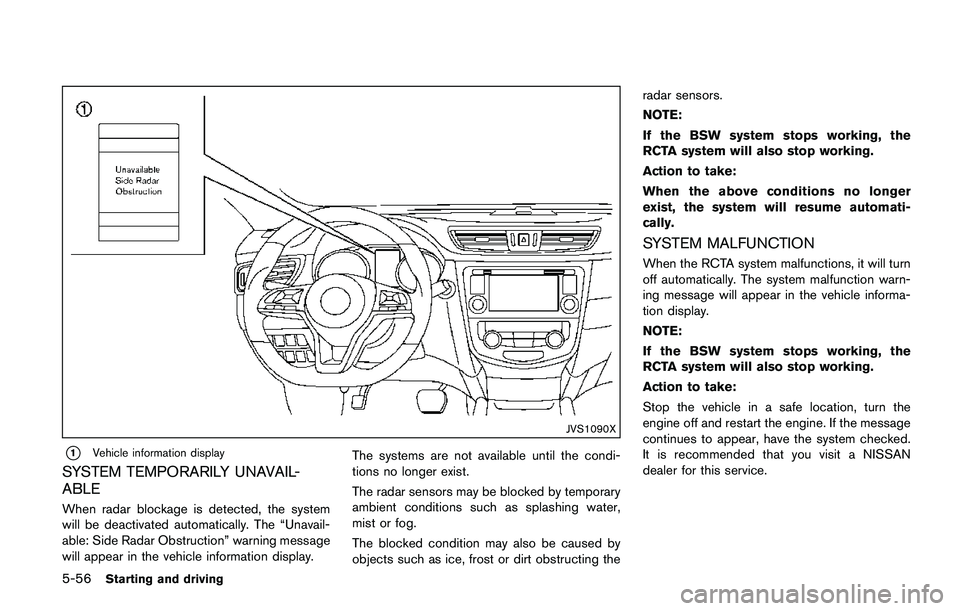
5-56Starting and driving
JVS1090X
*1Vehicle information display
SYSTEM TEMPORARILY UNAVAIL-
ABLE
When radar blockage is detected, the system
will be deactivated automatically. The “Unavail-
able: Side Radar Obstruction” warning message
will appear in the vehicle information display.The systems are not available until the condi-
tions no longer exist.
The radar sensors may be blocked by temporary
ambient conditions such as splashing water,
mist or fog.
The blocked condition may also be caused by
objects such as ice, frost or dirt obstructing theradar sensors.
NOTE:
If the BSW system stops working, the
RCTA system will also stop working.
Action to take:
When the above conditions no longer
exist, the system will resume automati-
cally.
SYSTEM MALFUNCTION
When the RCTA system malfunctions, it will turn
off automatically. The system malfunction warn-
ing message will appear in the vehicle informa-
tion display.
NOTE:
If the BSW system stops working, the
RCTA system will also stop working.
Action to take:
Stop the vehicle in a safe location, turn the
engine off and restart the engine. If the message
continues to appear, have the system checked.
It is recommended that you visit a NISSAN
dealer for this service.
Page 342 of 508
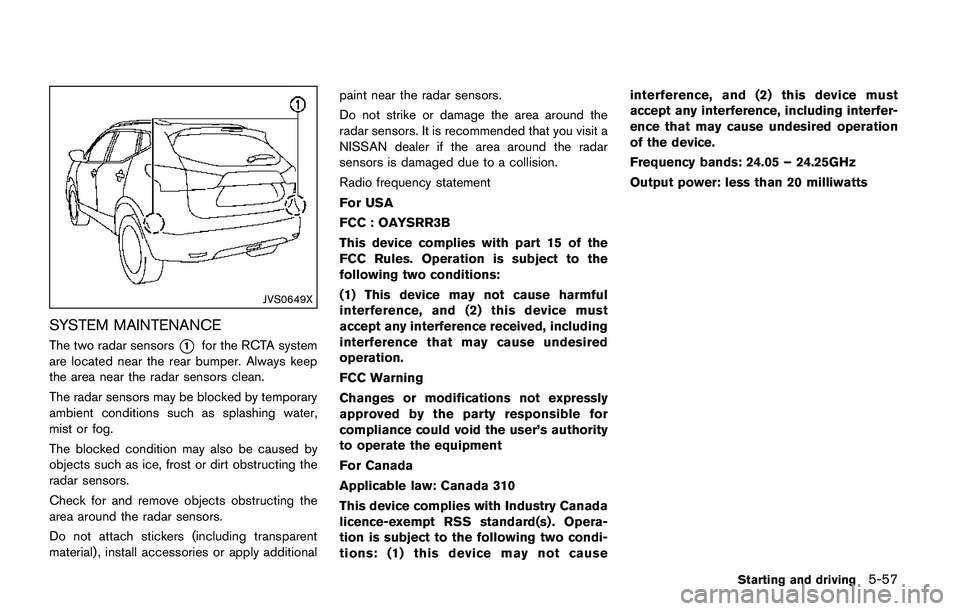
JVS0649X
SYSTEM MAINTENANCE
The two radar sensors*1for the RCTA system
are located near the rear bumper. Always keep
the area near the radar sensors clean.
The radar sensors may be blocked by temporary
ambient conditions such as splashing water,
mist or fog.
The blocked condition may also be caused by
objects such as ice, frost or dirt obstructing the
radar sensors.
Check for and remove objects obstructing the
area around the radar sensors.
Do not attach stickers (including transparent
material) , install accessories or apply additionalpaint near the radar sensors.
Do not strike or damage the area around the
radar sensors. It is recommended that you visit a
NISSAN dealer if the area around the radar
sensors is damaged due to a collision.
Radio frequency statement
For USA
FCC : OAYSRR3B
This device complies with part 15 of the
FCC Rules. Operation is subject to the
following two conditions:
(1) This device may not cause harmful
interference, and (2) this device must
accept any interference received, including
interference that may cause undesired
operation.
FCC Warning
Changes or modifications not expressly
approved by the party responsible for
compliance could void the user’s authority
to operate the equipment
For Canada
Applicable law: Canada 310
This device complies with Industry Canada
licence-exempt RSS standard(s) . Opera-
tion is subject to the following two condi-
tions: (1) this device may not causeinterference, and (2) this device must
accept any interference, including interfer-
ence that may cause undesired operation
of the device.
Frequency bands: 24.05 – 24.25GHz
Output power: less than 20 milliwatts
Starting and driving5-57
Page 343 of 508
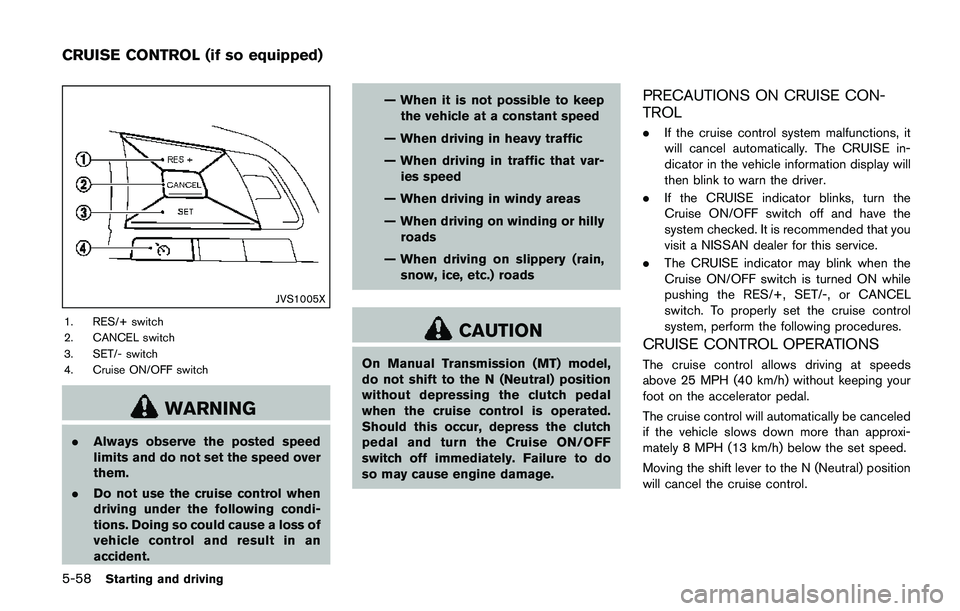
5-58Starting and driving
JVS1005X
1. RES/+ switch
2. CANCEL switch
3. SET/- switch
4. Cruise ON/OFF switch
WARNING
.Always observe the posted speed
limits and do not set the speed over
them.
.Do not use the cruise control when
driving under the following condi-
tions. Doing so could cause a loss of
vehicle control and result in an
accident.— When it is not possible to keep
the vehicle at a constant speed
— When driving in heavy traffic
— When driving in traffic that var-
ies speed
— When driving in windy areas
— When driving on winding or hilly
roads
— When driving on slippery (rain,
snow, ice, etc.) roads
CAUTION
On Manual Transmission (MT) model,
do not shift to the N (Neutral) position
without depressing the clutch pedal
when the cruise control is operated.
Should this occur, depress the clutch
pedal and turn the Cruise ON/OFF
switch off immediately. Failure to do
so may cause engine damage.
PRECAUTIONS ON CRUISE CON-
TROL
.If the cruise control system malfunctions, it
will cancel automatically. The CRUISE in-
dicator in the vehicle information display will
then blink to warn the driver.
.If the CRUISE indicator blinks, turn the
Cruise ON/OFF switch off and have the
system checked. It is recommended that you
visit a NISSAN dealer for this service.
.The CRUISE indicator may blink when the
Cruise ON/OFF switch is turned ON while
pushing the RES/+, SET/-, or CANCEL
switch. To properly set the cruise control
system, perform the following procedures.
CRUISE CONTROL OPERATIONS
The cruise control allows driving at speeds
above 25 MPH (40 km/h) without keeping your
foot on the accelerator pedal.
The cruise control will automatically be canceled
if the vehicle slows down more than approxi-
mately 8 MPH (13 km/h) below the set speed.
Moving the shift lever to the N (Neutral) position
will cancel the cruise control.
CRUISE CONTROL (if so equipped)
Page 344 of 508

Turning on cruise control
Push the Cruise ON/OFF switch. The CRUISE
indicator in the vehicle information display will
appear.
Setting cruising speed
1. Accelerate to the desired speed.
2. Push the SET/- switch and release it.
3. Take your foot off the accelerator pedal.
The vehicle will maintain the set speed.
Passing another vehicle:
Depress the accelerator pedal to accelerate.
After releasing the accelerator pedal, the vehicle
will return to the previously set speed.
The vehicle may not maintain the set speed
when going up or down steep hills. In such
cases, drive without the cruise control.
Resetting to slower speed:
Use any one of the following methods to reset to
a slower speed.
.Lightly tap the foot brake pedal. When the
vehicle reaches the desired speed, push
and release the SET/- switch.
.Push and hold the SET/- switch. When the
vehicle reaches the desired speed, release
the SET- switch..Quickly push and release the SET/- switch.
This will reduce the vehicle speed by about
1 MPH (1.6 km/h) .
Resetting to faster speed:
Use any one of the following methods to reset to
a faster speed.
.Depress the accelerator pedal. When the
vehicle reaches the desired speed, push
and release the SET/- switch.
.Push and hold the RES/+switch. When the
vehicle reaches the desired speed, release
the RES/+ switch.
.Quickly push and release the RES/+ switch.
This will increase the vehicle speed by about
1 MPH (1.6 km/h) .
Resuming at preset speed:
Push and release the RES/+ switch.
The vehicle will resume the last set cruising
speed when the vehicle speed is over 25 MPH
(40 km/h) .
Cancelling cruising speed
Use any one of the following methods to cancel
the set speed.
.Push the CANCEL switch.
.Tap the foot brake pedal..Push the Cruise ON/OFF switch. The
CRUISE indicator will turn off.
Starting and driving5-59
Page 345 of 508
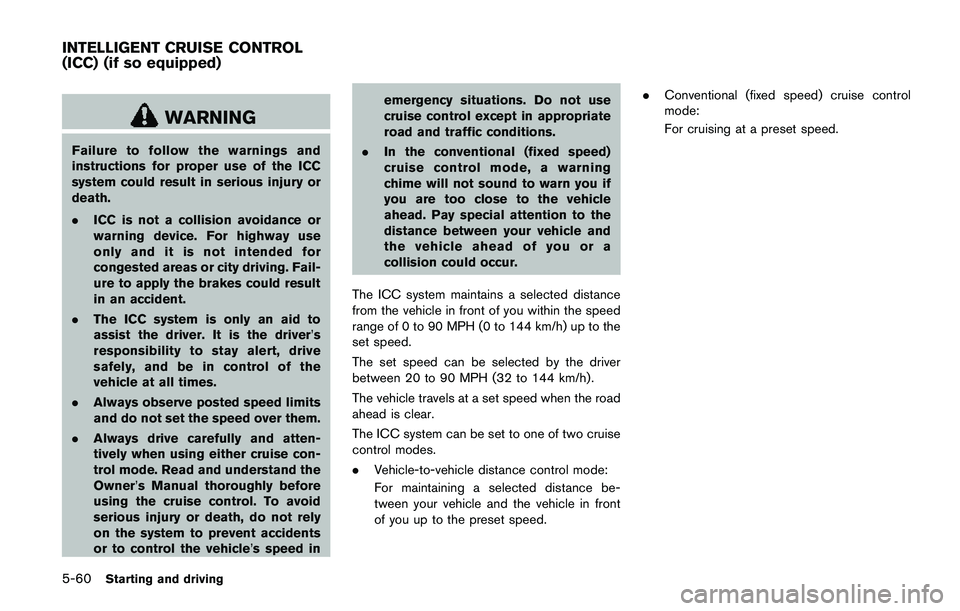
5-60Starting and driving
WARNING
Failure to follow the warnings and
instructions for proper use of the ICC
system could result in serious injury or
death.
.ICC is not a collision avoidance or
warning device. For highway use
only and it is not intended for
congested areas or city driving. Fail-
ure to apply the brakes could result
in an accident.
.The ICC system is only an aid to
assist the driver. It is the driver’s
responsibility to stay alert, drive
safely, and be in control of the
vehicle at all times.
.Always observe posted speed limits
and do not set the speed over them.
.Always drive carefully and atten-
tively when using either cruise con-
trol mode. Read and understand the
Owner’s Manual thoroughly before
using the cruise control. To avoid
serious injury or death, do not rely
on the system to prevent accidents
or to control the vehicle’s speed inemergency situations. Do not use
cruise control except in appropriate
road and traffic conditions.
.In the conventional (fixed speed)
cruise control mode, a warning
chime will not sound to warn you if
you are too close to the vehicle
ahead. Pay special attention to the
distance between your vehicle and
the vehicle ahead of you or a
collision could occur.
The ICC system maintains a selected distance
from the vehicle in front of you within the speed
range of 0 to 90 MPH (0 to 144 km/h) up to the
set speed.
The set speed can be selected by the driver
between 20 to 90 MPH (32 to 144 km/h) .
The vehicle travels at a set speed when the road
ahead is clear.
The ICC system can be set to one of two cruise
control modes.
.Vehicle-to-vehicle distance control mode:
For maintaining a selected distance be-
tween your vehicle and the vehicle in front
of you up to the preset speed..Conventional (fixed speed) cruise control
mode:
For cruising at a preset speed.
INTELLIGENT CRUISE CONTROL
(ICC) (if so equipped)
Page 346 of 508
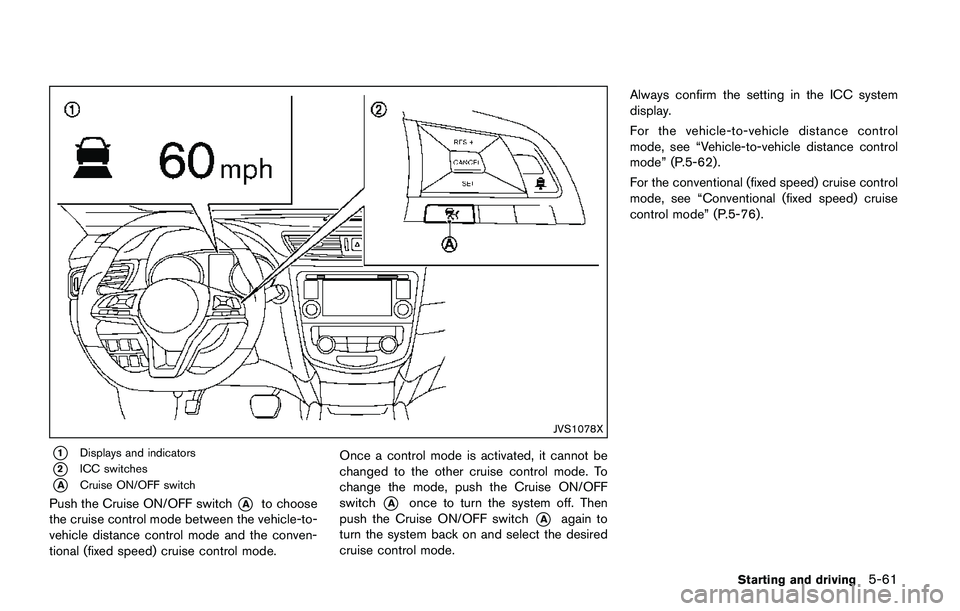
JVS1078X
*1Displays and indicators
*2ICC switches
*ACruise ON/OFF switch
Push the Cruise ON/OFF switch*Ato choose
the cruise control mode between the vehicle-to-
vehicle distance control mode and the conven-
tional (fixed speed) cruise control mode.Once a control mode is activated, it cannot be
changed to the other cruise control mode. To
change the mode, push the Cruise ON/OFF
switch*Aonce to turn the system off. Then
push the Cruise ON/OFF switch
*Aagain to
turn the system back on and select the desired
cruise control mode.Always confirm the setting in the ICC system
display.
For the vehicle-to-vehicle distance control
mode, see “Vehicle-to-vehicle distance control
mode” (P.5-62) .
For the conventional (fixed speed) cruise control
mode, see “Conventional (fixed speed) cruise
control mode” (P.5-76).
Starting and driving5-61
Page 347 of 508
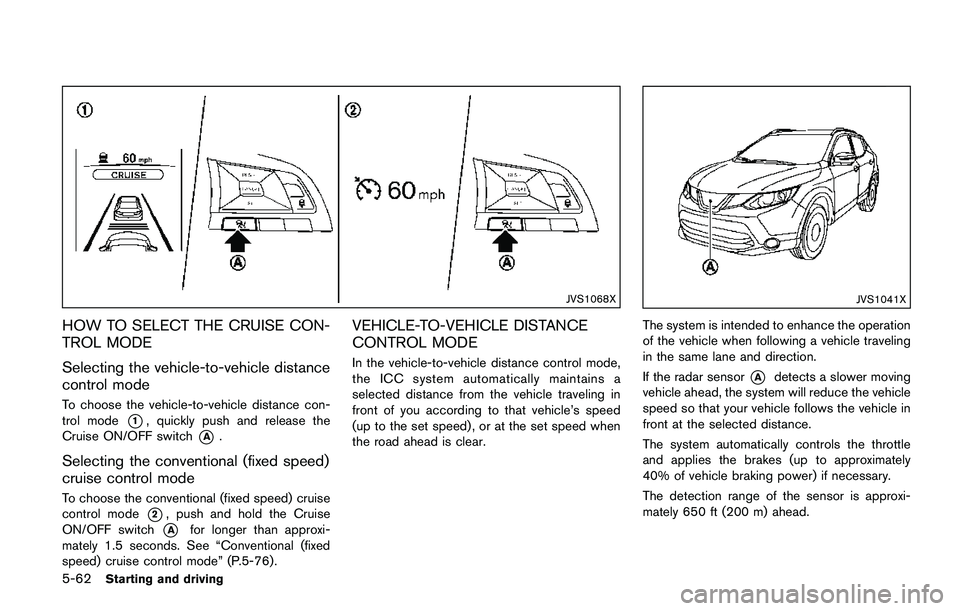
5-62Starting and driving
JVS1068X
HOW TO SELECT THE CRUISE CON-
TROL MODE
Selecting the vehicle-to-vehicle distance
control mode
To choose the vehicle-to-vehicle distance con-
trol mode
*1, quickly push and release the
Cruise ON/OFF switch
*A.
Selecting the conventional (fixed speed)
cruise control mode
To choose the conventional (fixed speed) cruise
control mode
*2, push and hold the Cruise
ON/OFF switch
*Afor longer than approxi-
mately 1.5 seconds. See “Conventional (fixed
speed) cruise control mode” (P.5-76) .
VEHICLE-TO-VEHICLE DISTANCE
CONTROL MODE
In the vehicle-to-vehicle distance control mode,
the ICC system automatically maintains a
selected distance from the vehicle traveling in
front of you according to that vehicle’s speed
(up to the set speed) , or at the set speed when
the road ahead is clear.
JVS1041X
The system is intended to enhance the operation
of the vehicle when following a vehicle traveling
in the same lane and direction.
If the radar sensor
*Adetects a slower moving
vehicle ahead, the system will reduce the vehicle
speed so that your vehicle follows the vehicle in
front at the selected distance.
The system automatically controls the throttle
and applies the brakes (up to approximately
40% of vehicle braking power) if necessary.
The detection range of the sensor is approxi-
mately 650 ft (200 m) ahead.
Page 348 of 508
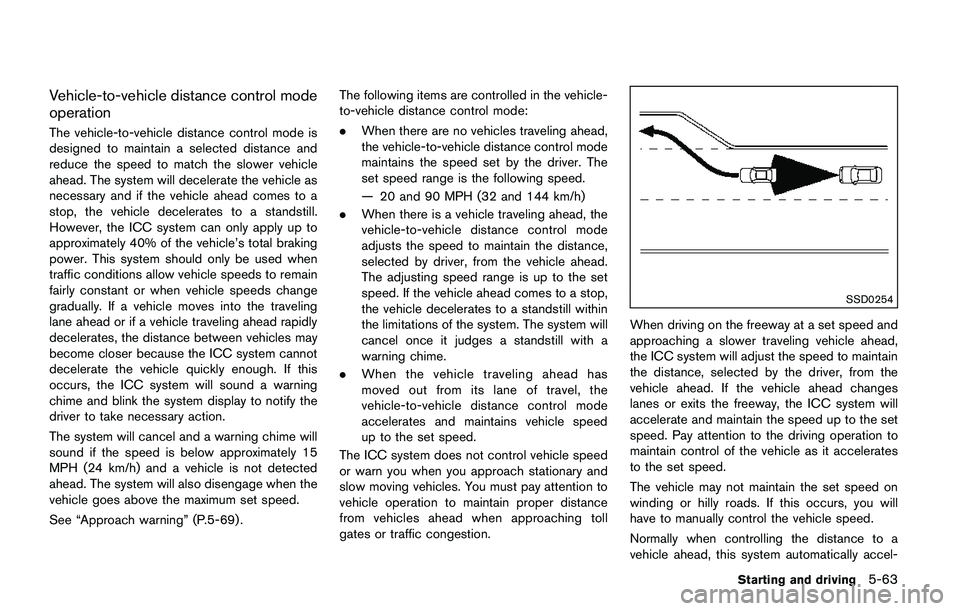
Vehicle-to-vehicle distance control mode
operation
The vehicle-to-vehicle distance control mode is
designed to maintain a selected distance and
reduce the speed to match the slower vehicle
ahead. The system will decelerate the vehicle as
necessary and if the vehicle ahead comes to a
stop, the vehicle decelerates to a standstill.
However, the ICC system can only apply up to
approximately 40% of the vehicle’s total braking
power. This system should only be used when
traffic conditions allow vehicle speeds to remain
fairly constant or when vehicle speeds change
gradually. If a vehicle moves into the traveling
lane ahead or if a vehicle traveling ahead rapidly
decelerates, the distance between vehicles may
become closer because the ICC system cannot
decelerate the vehicle quickly enough. If this
occurs, the ICC system will sound a warning
chime and blink the system display to notify the
driver to take necessary action.
The system will cancel and a warning chime will
sound if the speed is below approximately 15
MPH (24 km/h) and a vehicle is not detected
ahead. The system will also disengage when the
vehicle goes above the maximum set speed.
See “Approach warning” (P.5-69).The following items are controlled in the vehicle-
to-vehicle distance control mode:
.When there are no vehicles traveling ahead,
the vehicle-to-vehicle distance control mode
maintains the speed set by the driver. The
set speed range is the following speed.
— 20 and 90 MPH (32 and 144 km/h)
.When there is a vehicle traveling ahead, the
vehicle-to-vehicle distance control mode
adjusts the speed to maintain the distance,
selected by driver, from the vehicle ahead.
The adjusting speed range is up to the set
speed. If the vehicle ahead comes to a stop,
the vehicle decelerates to a standstill within
the limitations of the system. The system will
cancel once it judges a standstill with a
warning chime.
.When the vehicle traveling ahead has
moved out from its lane of travel, the
vehicle-to-vehicle distance control mode
accelerates and maintains vehicle speed
up to the set speed.
The ICC system does not control vehicle speed
or warn you when you approach stationary and
slow moving vehicles. You must pay attention to
vehicle operation to maintain proper distance
from vehicles ahead when approaching toll
gates or traffic congestion.
SSD0254
When driving on the freeway at a set speed and
approaching a slower traveling vehicle ahead,
the ICC system will adjust the speed to maintain
the distance, selected by the driver, from the
vehicle ahead. If the vehicle ahead changes
lanes or exits the freeway, the ICC system will
accelerate and maintain the speed up to the set
speed. Pay attention to the driving operation to
maintain control of the vehicle as it accelerates
to the set speed.
The vehicle may not maintain the set speed on
winding or hilly roads. If this occurs, you will
have to manually control the vehicle speed.
Normally when controlling the distance to a
vehicle ahead, this system automatically accel-
Starting and driving5-63
Page 349 of 508
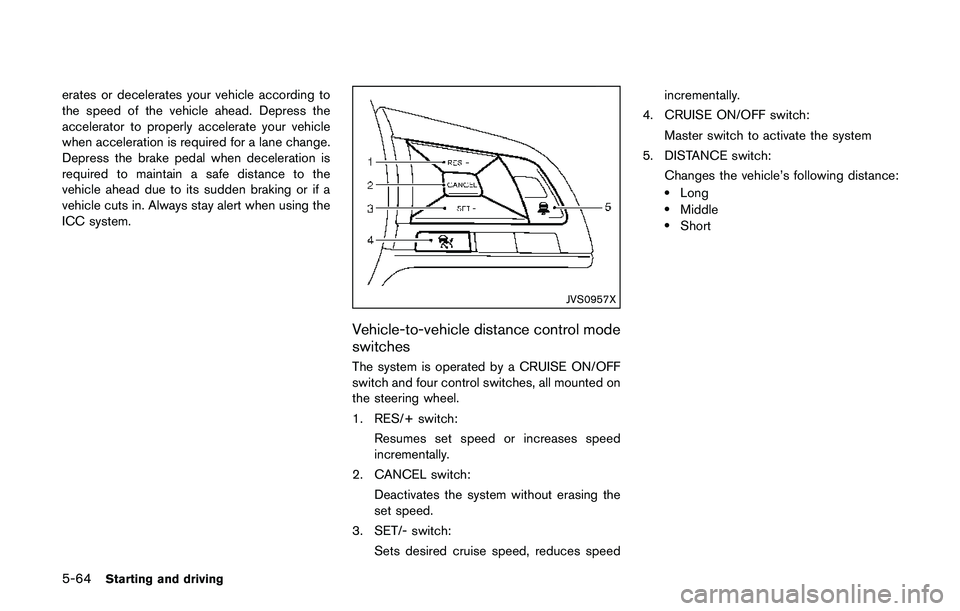
5-64Starting and driving
erates or decelerates your vehicle according to
the speed of the vehicle ahead. Depress the
accelerator to properly accelerate your vehicle
when acceleration is required for a lane change.
Depress the brake pedal when deceleration is
required to maintain a safe distance to the
vehicle ahead due to its sudden braking or if a
vehicle cuts in. Always stay alert when using the
ICC system.
JVS0957X
Vehicle-to-vehicle distance control mode
switches
The system is operated by a CRUISE ON/OFF
switch and four control switches, all mounted on
the steering wheel.
1. RES/+ switch:
Resumes set speed or increases speed
incrementally.
2. CANCEL switch:
Deactivates the system without erasing the
set speed.
3. SET/- switch:
Sets desired cruise speed, reduces speedincrementally.
4. CRUISE ON/OFF switch:
Master switch to activate the system
5. DISTANCE switch:
Changes the vehicle’s following distance:
.Long.Middle.Short
Page 350 of 508
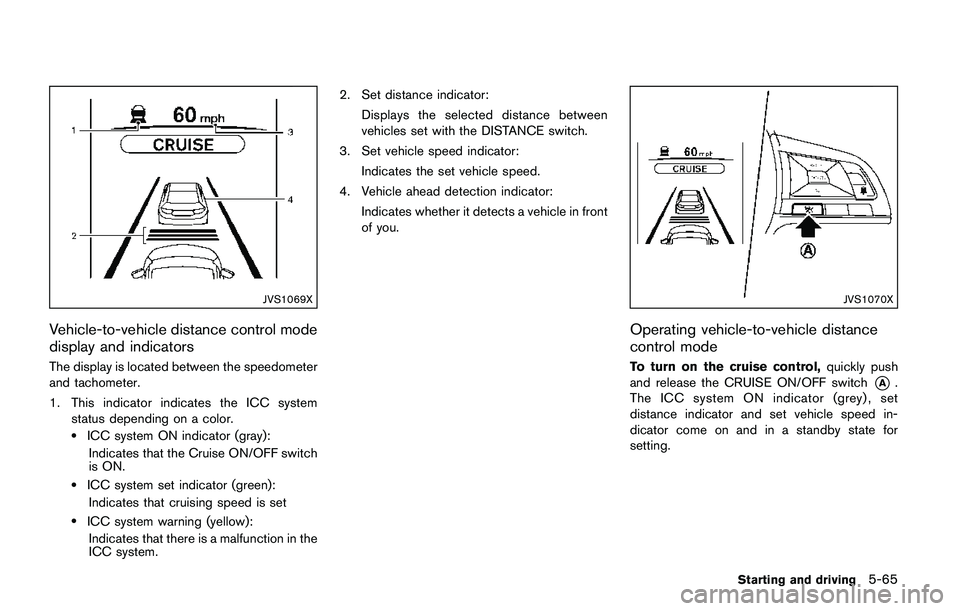
JVS1069X
Vehicle-to-vehicle distance control mode
display and indicators
The display is located between the speedometer
and tachometer.
1. This indicator indicates the ICC system
status depending on a color.
.ICC system ON indicator (gray):
Indicates that the Cruise ON/OFF switch
is ON.
.ICC system set indicator (green):
Indicates that cruising speed is set
.ICC system warning (yellow):
Indicates that there is a malfunction in the
ICC system.2. Set distance indicator:
Displays the selected distance between
vehicles set with the DISTANCE switch.
3. Set vehicle speed indicator:
Indicates the set vehicle speed.
4. Vehicle ahead detection indicator:
Indicates whether it detects a vehicle in front
of you.
JVS1070X
Operating vehicle-to-vehicle distance
control mode
To turn on the cruise control,quickly push
and release the CRUISE ON/OFF switch
*A.
The ICC system ON indicator (grey) , set
distance indicator and set vehicle speed in-
dicator come on and in a standby state for
setting.
Starting and driving5-65